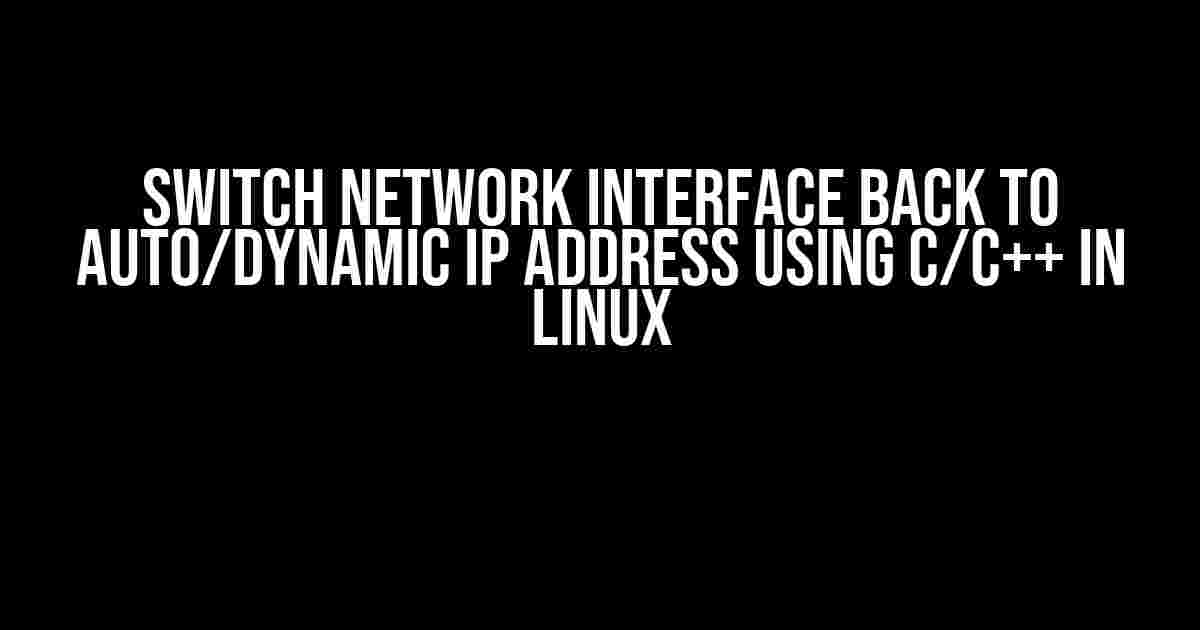Are you tired of dealing with static IP addresses and want to switch your network interface back to auto or dynamic IP addressing? Look no further! In this article, we’ll explore how to do just that using C/C++ in Linux. We’ll dive into the world of Linux networking, explore the benefits of dynamic IP addressing, and provide step-by-step instructions on how to switch your network interface back to auto/dynamic IP addressing using C/C++.
What is Dynamic IP Addressing?
Dynamic IP addressing, also known as DHCP (Dynamic Host Configuration Protocol), is a method of assigning IP addresses to devices on a network. Unlike static IP addressing, where IP addresses are manually configured, dynamic IP addressing allows devices to obtain an IP address automatically from a DHCP server. This approach offers several benefits, including:
- Easy network management**: Dynamic IP addressing makes it easier to manage a network, as devices can automatically obtain an IP address and connect to the network without manual configuration.
- Scalability**: Dynamic IP addressing allows for easier scalability, as new devices can be added to the network without worrying about IP address conflicts.
- Flexibility**: Dynamic IP addressing provides flexibility, as devices can move between networks and obtain a new IP address automatically.
Why Switch to Dynamic IP Addressing?
There are several reasons why you might want to switch your network interface back to auto/dynamic IP addressing:
- Convenience**: Dynamic IP addressing eliminates the need to manually configure IP addresses, making it a more convenient option.
- Portability**: Dynamic IP addressing allows devices to move between networks and obtain a new IP address automatically, making it ideal for devices that need to connect to different networks.
- Security**: Dynamic IP addressing can improve security, as IP addresses are not hardcoded and can be changed dynamically, making it harder for hackers to target a specific device.
Switching to Dynamic IP Addressing Using C/C++
To switch your network interface back to auto/dynamic IP addressing using C/C++, you’ll need to use the ifconfig and dhcpcd commands. Here’s a step-by-step guide:
Step 1: Install the Required Packages
Before you begin, make sure you have the required packages installed:
sudo apt-get update
sudo apt-get install dhcpcd5
Step 2: Configure the Network Interface
To switch to dynamic IP addressing, you’ll need to configure the network interface using the ifconfig command:
sudo ifconfig eth0 down
sudo ifconfig eth0 up
Replace eth0 with the name of your network interface.
Step 3: Start the DHCP Client
Next, you’ll need to start the DHCP client using the dhcpcd command:
sudo dhcpcd eth0
Replace eth0 with the name of your network interface.
Step 4: Verify the IP Address
To verify that the IP address has been assigned dynamically, use the ifconfig command:
sudo ifconfig eth0
This will display the current IP address configuration, including the dynamically assigned IP address.
Example C/C++ Code
Here’s an example C/C++ code that demonstrates how to switch the network interface back to auto/dynamic IP addressing:
#include <stdio.h>
#include <stdlib.h>
#include <string.h>
#include <sys/types.h>
#include <sys/socket.h>
#include <arpa/inet.h>
#include <net/if.h>
int main() {
// Set the network interface name
char *interface = "eth0";
// Configure the network interface
system("ifconfig " interface " down");
system("ifconfig " interface " up");
// Start the DHCP client
system("dhcpcd " interface);
// Verify the IP address
system("ifconfig " interface);
return 0;
}
Compile and run the code using:
gcc -o dynamic_ip dynamic_ip.c
./dynamic_ip
Troubleshooting Common Issues
Here are some common issues you might encounter when switching to dynamic IP addressing:
| Issue | Solution |
|---|---|
| IP address not assigned | Check that the DHCP server is configured correctly and that the network interface is properly configured. |
| DHCP client not starting | Check that the dhcpcd package is installed and that the command is run with the correct permissions. |
| Network interface not responding | Check that the network interface is properly configured and that the ifconfig command is run with the correct permissions. |
Conclusion
In this article, we’ve explored how to switch your network interface back to auto/dynamic IP addressing using C/C++ in Linux. We’ve discussed the benefits of dynamic IP addressing, including ease of network management, scalability, and flexibility. We’ve also provided step-by-step instructions and example C/C++ code to help you get started. By following these instructions, you’ll be able to switch your network interface back to auto/dynamic IP addressing and enjoy the benefits of dynamic IP addressing.
Remember to troubleshoot common issues and ensure that your network interface is properly configured. With dynamic IP addressing, you’ll be able to effortlessly manage your network and ensure that your devices can move between networks without manual configuration.
Additional Resources
For further reading, check out:
- The Linux man pages for
ifconfiganddhcpcd. - The Linux Network Administrators Guide.
- Online forums and communities, such as Stack Overflow and Reddit’s r/linux.
Frequently Asked Question
Get the inside scoop on how to switch your network interface back to an auto(dynamic) IP address using C/C++ in Linux!
What is the purpose of switching back to an auto IP address?
Switching back to an auto(dynamic) IP address allows your network interface to automatically obtain an IP address from a DHCP server, which is useful when you’re in a dynamic network environment or want to restore the default behavior of your network interface.
What is the command to switch back to an auto IP address in Linux?
The command to switch back to an auto IP address in Linux is `ip addr flush dev
How can I achieve this using C/C++ in Linux?
You can use the `system()` function in C/C++ to execute the commands mentioned above. For example: `system(“ip addr flush dev eth0”); system(“dhcpcd eth0”);`. Make sure to replace `eth0` with your actual interface name.
What if I want to switch back to an auto IP address at boot time?
You can add the commands to your system’s startup scripts (e.g., `/etc/rc.local` or `/etc/init.d/rc.local`) to run at boot time. This way, your network interface will automatically switch to an auto IP address after each reboot.
Are there any potential issues I should be aware of when switching back to an auto IP address?
Yes, be aware that switching back to an auto IP address may cause connectivity issues if your network environment doesn’t support DHCP or if your interface is configured to use a static IP address. Also, ensure that your system has a working DHCP client installed and configured properly.



